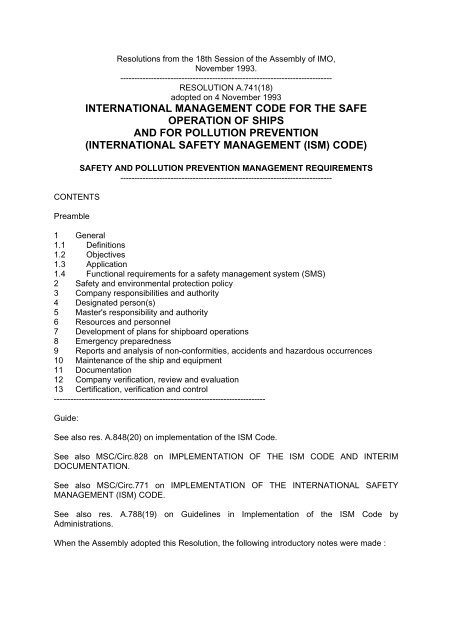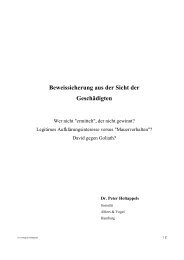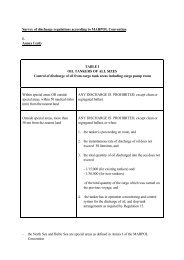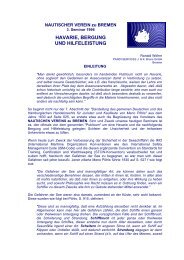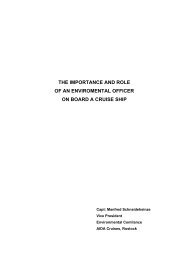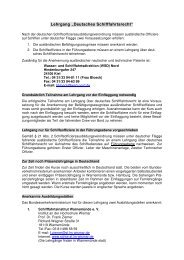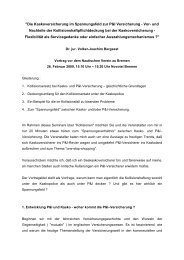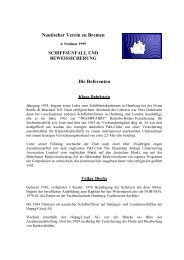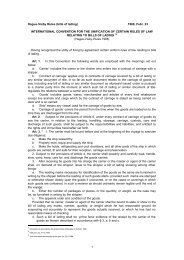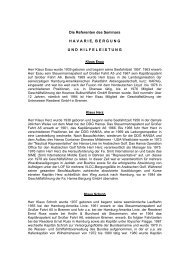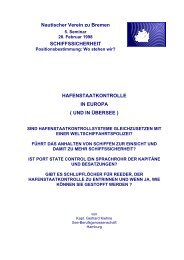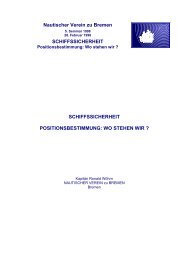IMO Resolution A.741
IMO Resolution A.741
IMO Resolution A.741
Create successful ePaper yourself
Turn your PDF publications into a flip-book with our unique Google optimized e-Paper software.
CONTENTS<br />
Preamble<br />
<strong>Resolution</strong>s from the 18th Session of the Assembly of <strong>IMO</strong>,<br />
November 1993.<br />
----------------------------------------------------------------------------<br />
RESOLUTION <strong>A.741</strong>(18)<br />
adopted on 4 November 1993<br />
INTERNATIONAL MANAGEMENT CODE FOR THE SAFE<br />
OPERATION OF SHIPS<br />
AND FOR POLLUTION PREVENTION<br />
(INTERNATIONAL SAFETY MANAGEMENT (ISM) CODE)<br />
SAFETY AND POLLUTION PREVENTION MANAGEMENT REQUIREMENTS<br />
----------------------------------------------------------------------------<br />
1 General<br />
1.1 Definitions<br />
1.2 Objectives<br />
1.3 Application<br />
1.4 Functional requirements for a safety management system (SMS)<br />
2 Safety and environmental protection policy<br />
3 Company responsibilities and authority<br />
4 Designated person(s)<br />
5 Master's responsibility and authority<br />
6 Resources and personnel<br />
7 Development of plans for shipboard operations<br />
8 Emergency preparedness<br />
9 Reports and analysis of non-conformities, accidents and hazardous occurrences<br />
10 Maintenance of the ship and equipment<br />
11 Documentation<br />
12 Company verification, review and evaluation<br />
13 Certification, verification and control<br />
----------------------------------------------------------------------------<br />
Guide:<br />
See also res. A.848(20) on implementation of the ISM Code.<br />
See also MSC/Circ.828 on IMPLEMENTATION OF THE ISM CODE AND INTERIM<br />
DOCUMENTATION.<br />
See also MSC/Circ.771 on IMPLEMENTATION OF THE INTERNATIONAL SAFETY<br />
MANAGEMENT (ISM) CODE.<br />
See also res. A.788(19) on Guidelines in Implementation of the ISM Code by<br />
Administrations.<br />
When the Assembly adopted this <strong>Resolution</strong>, the following introductory notes were made :
THE ASSEMBLY,<br />
RECALLING Article 15(j) of the Convention on the International Maritime Organization<br />
concerning the functions of the Assembly in relation to regulations and guidelines concerning<br />
maritime safety and the prevention and control of marine pollution from ships,<br />
RECALLING ALSO resolution A.680(17), by which it invited Member Governments to<br />
encourage those responsible for the management and operation of ships to take appropriate<br />
steps to develop, implement and assess safety and pollution prevention management in<br />
accordance with the <strong>IMO</strong> Guidelines on management for the safe operation of ships and for<br />
pollution prevention,<br />
RECALLING ALSO resolution A.596(15), by which it requested theMaritime Safety<br />
Committee to develop, as a matter of urgency, guidelines, wherever relevant, concerning<br />
shipboard and shore-based management and its decision to include in the work programme<br />
of the Maritime Safety Committee and the Marine Environment Protection Committee an item<br />
on shipboard and shore-based management for the safe operation of ships and for the<br />
prevention of marine pollution, respectively,<br />
RECALLING FURTHER resolution A.441(XI), by which it invited every State to take the<br />
necessary steps to ensure that the owner of a ship which flies the flag of that State provides<br />
such State with the current information necessary to enable it to identify and contact the<br />
person contracted or otherwise entrusted by the owner to discharge his responsibilities for<br />
that ship in regard to matters relating to maritime safety and the protection of the marine<br />
environment,<br />
FURTHER RECALLING resolution A.443(XI), by which it invited Governments to take the<br />
necessary steps to safeguard the shipmaster in the proper discharge of his responsibilities in<br />
regard to maritime safety and the protection of the marine environment,<br />
RECOGNIZING the need for appropriate organization of management to enable it to<br />
respond to the need of those on board ships to achieve and maintain high standards of<br />
safety and environmental protection,<br />
RECOGNIZING ALSO that the most important means of preventing maritime casualties<br />
and pollution of the sea from ships is to design, construct, equip and maintain ships and to<br />
operate them with properly trained crews in compliance with international conventions and<br />
standards relating to maritime safety and pollution prevention,<br />
NOTING that the Maritime Safety Committee is developing requirements for adoption by<br />
Contracting Governments to the International Convention for the Safety of Life at Sea<br />
(SOLAS) 1974, which will make compliance with the Code referred to in operative paragraph<br />
1 mandatory,<br />
CONSIDERING that the early implementation of that Code would greatly assist in<br />
improving safety at sea and protection of the marine environment,<br />
NOTING FURTHER that the Maritime Safety Committee and the Marine Environment<br />
Protection Committee have reviewed resolution A.680(17) and the Guidelines annexed<br />
thereto in developing the Code,<br />
HAVING CONSIDERED the recommendations made by the Maritime Safety Committee at<br />
its sixty-second session and by the Marine Environment Protection Committee at its thirtyfourth<br />
session,<br />
NV Seminar 2001 - ISM - Code -Annex <strong>A.741</strong><br />
2
1. ADOPTS the International Management Code for the Safe Operation of Ships and for<br />
Pollution Prevention, (International Safety Management (ISM) Code), set out in the Annex to<br />
the present resolution;<br />
2. STRONGLY URGES Governments to implement the ISM Code on a national basis,giving<br />
priority to passenger ships, tankers, gas carriers, bulk carriers and mobile offshoreunits,<br />
which are flying their flags, as soon as possible but not later than 1 June 1998,<br />
pendingdevelopment of the mandatory applications of the Code;<br />
3. REQUESTS GOVERNMENTS to inform the Maritime Safety Committee and the Marine<br />
Environment Protection Committee of the action they have taken in implementing the ISM<br />
Code;<br />
4. REQUESTS the Maritime Safety Committee and the Marine Environment Protection<br />
Committee to develop Guidelines for the implementation of the ISM Code;<br />
5 REQUESTS ALSO the Maritime Safety Committee and the Marine Environment<br />
Protection Committee to keep the Code and ist associated Guidelines, under review and to<br />
amend them, as necessary;<br />
6. REVOKES resolution A.680(17).<br />
NV Seminar 2001 - ISM - Code -Annex <strong>A.741</strong><br />
3
<strong>Resolution</strong>s from the 18th Session of the Assembly of <strong>IMO</strong>, November 1993.<br />
----------------------------------------------------------------------------<br />
RESOLUTION <strong>A.741</strong>(18)<br />
adopted on 4 November 1993<br />
INTERNATIONAL MANAGEMENT CODE FOR THE SAFE OPERATION OF SHIPS<br />
AND FOR POLLUTION PREVENTION<br />
(INTERNATIONAL SAFETY MANAGEMENT (ISM) CODE)<br />
1 GENERAL<br />
SAFETY AND POLLUTION PREVENTION MANAGEMENT REQUIREMENTS<br />
----------------------------------------------------------------------------<br />
1.1 Definitions<br />
1.1.1 "International Safety Management (ISM) Code" means the International Management<br />
Code for the Safe Operation of Ships and for Pollution Prevention as adopted by the<br />
Assembly, as may be amended by the Organization.<br />
1.1.2 "Company" means the Owner of the ship or any other organization or person such as<br />
the Manager, or the Bareboat Charterer, who has assumed the responsibility for operation of<br />
the ship from the Shipowner and who on assuming such responsibility has agreed to take<br />
over all the duties and responsibility imposed by the Code.<br />
1.1.3 "Administration" means the Government of the State whose flag the ship is entitled to<br />
fly.<br />
1.2 Objectives<br />
1.2.1 The objectives of the Code are to ensure safety at sea, prevention of human injury or<br />
loss of life, and avoidance of damage to the environment, in particular, to the marine<br />
environment, and to property.<br />
1.2.2 Safety management objectives of the Company should, inter alia:<br />
.1 provide for safe practices in ship operation and a safe working environment;<br />
.2 establish safeguards against all identified risks; and<br />
.3 continuously improve safety management skills of personnel ashore and aboard ships,<br />
including preparing for emergencies related both to safety and environmental protection.<br />
1.2.3 The safety and management system should ensure:<br />
.1 compliance with mandatory rules and regulations; and<br />
.2 that applicable codes, guidelines and standards recommended by the Organization,<br />
Administrations, classification societies and maritime industry organizations are taken into<br />
account.<br />
1.3 Application<br />
The requirements of this Code may be applied to all ships.<br />
NV Seminar 2001 - ISM - Code -Annex <strong>A.741</strong><br />
4
1.4 Functional requirements for a Safety Management System (SMS)<br />
Every Company should develop, implement and maintain a Safety Management System<br />
(SMS) which includes the following functional requirements:<br />
.1 a safety and environmental protection policy;<br />
.2 instructions and procedures to ensure safe operation of ships and protection of the<br />
environment in compliance with relevant international and flag State legislation;<br />
.3 defined levels of authority and lines of communication between, and amongst, shore<br />
and shipboard personnel;<br />
.4 procedures for reporting accidents and non-conformities with the provisions of this<br />
Code;<br />
.5 procedures to prepare for and respond to emergency situations; and<br />
.6 procedures for internal audits and management reviews.<br />
2 SAFETY AND ENVIRONMENTAL PROTECTION POLICY<br />
2.1 The Company should establish a safety and environmental protection policy which<br />
describes how the objectives, given in paragraph 1.2, will be achieved.<br />
2.2 The Company should ensure that the policy is implemented and maintained at all levels<br />
of the organization both ship based as well as shore based.<br />
3 COMPANY RESPONSIBILITIES AND AUTHORITY<br />
3.1 If the entity who is responsible for the operation of the ship is other than the owner, the<br />
owner must report the full name and details of such entity to the Administration.<br />
3.2 The Company should define and document the responsibility, authority and interrelation<br />
of all personnel who manage, perform and verify work relating to and affecting safety and<br />
pollution prevention.<br />
3.3 The Company is responsible for ensuring that adequate resources and shore based<br />
support are provided to enable the designated person or persons to carry out their functions.<br />
4 DESIGNATED PERSON(S)<br />
To ensure the safe operation of each ship and to provide a link between the company and<br />
those on board, every company, as appropriate, should designate a person or persons<br />
ashore having direct access to the highest level of management. The responsibility and<br />
authority of the designated person or persons should include monitoring the safety and<br />
pollution prevention aspects of the operation of each ship and to ensure that adequate<br />
resources and shore based support are applied, as required.<br />
5 MASTER'S RESPONSIBILITY AND AUTHORITY<br />
5.1 The Company should clearly define and document the master's responsibility with regard<br />
to:<br />
.1 implementing the safety and environmental protection policy of the Company;<br />
NV Seminar 2001 - ISM - Code -Annex <strong>A.741</strong><br />
5
.2 motivating the crew in the observation of that policy;<br />
.3 issuing appropriate orders and instructions in a clear and simple manner;<br />
.4 verifying that specified requirements are observed; and<br />
.5 reviewing the SMS and reporting its deficiencies to the shore based management.<br />
5.2 The Company should ensure that the SMS operating on board the ship contains a clear<br />
statement emphasizing the Master's authority. The Company should establish in the SMS<br />
that the master has the overriding authority and the responsibility to make decisions with<br />
respect to safety and pollution prevention and to request the Company's assistance as may<br />
be necessary.<br />
6 RESOURCES AND PERSONNEL<br />
6.1 The Company should ensure that the master is:<br />
.1 properly qualified for command;<br />
.2 fully conversant with the Company's SMS; and<br />
.3 given the necessary support so that the Master's duties can be safely performed.<br />
6.2 The Company should ensure that each ship is manned with qualified, certificated and<br />
medically fit seafarers in accordance with national and international requirements.<br />
6.3 The Company should establish procedures to ensure that new personnel and personnel<br />
transferred to new assignments related to safety and protection of the environment are given<br />
proper familiarization with their duties. Instructions which are essential to be provided prior<br />
to sailing should be identified, documented and given.<br />
6.4 The Company should ensure that all personnel involved in the Company's SMS have an<br />
adequate understanding of relevant rules, regulations, codes and guidelines.<br />
6.5 The Company should establish and maintain procedures for identifying any training<br />
which may be required in support of the SMS and ensure that such training is provided for all<br />
personnel concerned.<br />
6.6 The Company should establish procedures by which the ship's personnel receive<br />
relevant information on the SMS in a working language or languages understood by them.<br />
6.7 The Company should ensure that the ship's personnel are able to communicate<br />
effectively in the execution of their duties related to the SMS.<br />
7 DEVELOPMENT OF PLANS FOR SHIPBOARD OPERATIONS<br />
The Company should establish procedures for the preparation of plans and instructions for<br />
key shipboard operations concerning the safety of the ship and the prevention of pollution.<br />
The various tasks involved should be defined and assigned to qualified personnel.<br />
NV Seminar 2001 - ISM - Code -Annex <strong>A.741</strong><br />
6
8 EMERGENCY PREPAREDNESS<br />
8.1 The Company should establish procedures to identify, describe and respond to potential<br />
emergency shipboard situations.<br />
8.2 The Company should establish programmes for drills and exercises to prepare for<br />
emergency actions.<br />
8.3 The SMS should provide for measures ensuring that the Company's organization can<br />
respond at any time to hazards, accidents and emergency situations involving its ships.<br />
9 REPORTS AND ANALYSIS OF NON-CONFORMITIES, ACCIDENTS AND<br />
HAZARDOUS OCCURRENCES<br />
9.1 The SMS should include procedures ensuring that non-conformities, accidents and<br />
hazardous situations are reported to the Company, investigated and analyzed with the<br />
objective of improving safety and pollution prevention.<br />
9.2 The Company should establish procedures for the implementation of corrective action.<br />
10 MAINTENANCE OF THE SHIP AND EQUIPMENT<br />
10.1 The Company should establish procedures to ensure that the ship is maintained in<br />
conformity with the provisions of the relevant rules and regulations and with any additional<br />
requirements which may be established by the Company.<br />
10.2 In meeting these requirements the Company should ensure that:<br />
.1 inspections are held at appropriate intervals;<br />
.2 any non-conformity is reported with its possible cause, if known;<br />
.3 appropriate corrective action is taken; and<br />
.4 records of these activities are maintained.<br />
10.3 The Company should establish procedures in SMS to identify equipment and technical<br />
systems the sudden operational failure of which may result in hazardous situations. The SMS<br />
should provide for specific measures aimed at promoting the reliability of such equipment or<br />
systems. These measures should include the regular testing of stand-by arrangements and<br />
equipment or technical systems that are not in continuous use.<br />
10.4 The inspections mentioned in 10.2 as well as the measures referred to 10.3 should be<br />
integrated in the ship's operational maintenance routine.<br />
11 DOCUMENTATION<br />
11.1 The Company should establish and maintain procedures to control all documents and<br />
data which are relevant to the SMS.<br />
11.2 The Company should ensure that:<br />
.1 valid documents are available at all relevant locations;<br />
NV Seminar 2001 - ISM - Code -Annex <strong>A.741</strong><br />
7
.2 changes to documents are reviewed and approved by authorized personnel; and<br />
.3 obsolete documents are promptly removed.<br />
11.3 The documents used to describe and implement the SMS may be referred to as the<br />
"Safety Management Manual". Documentation should be kept in a form that the Company<br />
considers most effective. Each ship should carry on board all documentation relevant to that<br />
ship.<br />
12 COMPANY VERIFICATION, REVIEW AND EVALUATION<br />
12.1 The Company should carry out internal safety audits to verify whether safety and<br />
pollution prevention activities comply with the SMS.<br />
12.2 The Company should periodically evaluate the efficiency and when needed review the<br />
SMS in accordance with procedures established<br />
12.3 The audits and possible corrective actions should be carried out in accordance with<br />
documented procedures.<br />
12.4 Personnel carrying out audits should be independent of the areas being audited unless<br />
this is impracticable due to the size and the nature of the Company.<br />
12.5 The results of the audits and reviews should be brought to the attention of all personnel<br />
having responsibility in the area involved.<br />
12.6 The management personnel responsible for the area involved should take timely<br />
corrective action on deficiencies found.<br />
13 CERTIFICATION, VERIFICATION AND CONTROL<br />
13.1 The ship should be operated by a Company which is issued a document of compliance<br />
relevant to that ship.<br />
13.2 A document of compliance should be issued for every Company complying with the<br />
requirements of the ISM Code by the Administration, by an organization recognized by the<br />
Administration or by the Government of the country, acting on behalf of the Administration in<br />
which the Company has chosen to conduct ist business. This document should be accepted<br />
as evidence that the Company is capable of complying with the requirements of the Code.<br />
13.3 A copy of such a document should be placed on board in order that the Master, if so<br />
asked, may produce it for the verification of the Administration or organizations recognized<br />
by it.<br />
13.4 A Certificate, called a Safety Management Certificate, should be issued to a ship by the<br />
Administration or organization recognized by the Administration. The Administration should,<br />
when issuing a certificate, verify that the Company and its shipboard management operate in<br />
accordance with the approved SMS.<br />
13.5 The Administration or an organization recognized by the Administration should<br />
periodically verify the proper functioning of the ship's SMS as approved.<br />
NV Seminar 2001 - ISM - Code -Annex <strong>A.741</strong><br />
8
Guide:<br />
See also draft amendments to the ISM Code contained in MSC/Circ.693 dated 26 May 1995.<br />
NV Seminar 2001 - ISM - Code -Annex <strong>A.741</strong><br />
9
RESOLUTION A.788(19)<br />
adopted on 23 November 1995<br />
GUIDELINES ON IMPLEMENTATION OF THE INTERNATIONAL<br />
SAFETY<br />
MANAGEMENT (ISM) CODE BY ADMINISTRATIONS<br />
ANNEX<br />
----------------------------------------------------------------------------<br />
TABLE OF CONTENTS<br />
INTRODUCTION<br />
1 SCOPE AND APPLICATION<br />
2 VERIFYING COMPLIANCE WITH THE ISM CODE<br />
3 ISSUANCE AND VALIDITY OF DOC AND SMC<br />
4 THE CERTIFICATION PROCESS<br />
APPENDIX 1 - STANDARDS ON ISM CODE CERTIFICATION ARRANGEMENTS<br />
1 INTRODUCTION<br />
2 STANDARD OF MANAGEMENT<br />
3 STANDARDS OF COMPETENCE<br />
4 QUALIFICATION ARRANGEMENTS<br />
5 CERTIFICATION PROCEDURES AND INSTRUCTIONS<br />
APPENDIX 2 - FORMS OF DOC AND SMC<br />
INTRODUCTION<br />
* * *<br />
The ISM Code<br />
The International Management Code for the Safe Operation of Ships and for Pollution<br />
Prevention (International Safety Management (ISM) Code) was adopted by the Organization<br />
by resolution <strong>A.741</strong>(18) and will be made mandatory by virtue of the entry into force on 1 July<br />
1998 of SOLAS chapter IX on Management for the Safe Operation of Ships. The ISM Code<br />
provides an international standard for the safe management and operation of ships and for<br />
pollution prevention:<br />
The ISM Code requires that Companies establish safety objectives as described in section<br />
1.2 of the ISM Code, and in addition that the Companies develop, implement and maintain a<br />
Safety Management System (SMS) which includes functional requirements as listed in<br />
section 1.4 of the ISM Code.<br />
The application of the ISM Code should support and encourage the development of a<br />
safety culture in shipping. Success factors for the development of a safety culture are, inter<br />
alia, commitment, values and beliefs.<br />
Mandatory application of the ISM Code<br />
The appropriate organisation of management, ashore and on board, is needed to ensure<br />
adequate standards of safety. A systematic approach to management by those responsible<br />
for management of ships is therefore required. The objectives of the mandatory application of<br />
the ISM Code are to ensure:<br />
NV Seminar 2001 - ISM - Code -Annex <strong>A.741</strong><br />
10
.1 compliance with mandatory rules and regulations related to the safe operation of ships<br />
and protection of the environment; and<br />
.2 the effective implementation and enforcement thereof by Administrations.<br />
Effective enforcement by Administrations must include verification that the Safety<br />
Management System (SMS) complies with the requirements as stipulated in the ISM Code,<br />
as well as verification of compliance with mandatory rules and regulations.<br />
The mandatory application of the ISM Code should ensure, support and encourage that<br />
applicable codes, guidelines and standards recommended by the Organization,<br />
Administrations, classification societies and maritime industry organisations are taken into<br />
account.<br />
Verification and certification responsibilities<br />
The Administration is responsible for verifying compliance with the requirements of the ISM<br />
Code and issuing Documents of Compliance (DOC) to Companies and Safety Management<br />
Certificates (SMC) to ships.<br />
<strong>Resolution</strong> A.739(18) Guidelines for the Authorization of Organizations Acting on Behalf of<br />
the Administration, which has been made mandatory by virtue of the new SOLAS chapter XI<br />
and resolution A.740(18) Interim Guidelines to Assist Flag States, are applicable when<br />
Administrations authorize organizations to issue DOC and SMC on<br />
their behalf.<br />
----------------------------------------------------------------------------<br />
Guide:<br />
See also MSC/Circ.828 dated 7 November 1997 on Implementation and interim<br />
documentation.<br />
When the Assembly adopted this <strong>Resolution</strong>, the following introductory notes were made :<br />
GUIDELINES ON IMPLEMENTATION OF THE INTERNATIONAL SAFETY<br />
MANAGEMENT (ISM) CODE BY ADMINISTRATIONS<br />
THE ASSEMBLY,<br />
RECALLING Article 15(j) of the Convention on the International Maritime Organization<br />
concerning the functions of the Assembly in relation to regulations and guidelines concerning<br />
maritime safety and the prevention and control of marine pollution from ships,<br />
RECALLING ALSO resolution <strong>A.741</strong>(18) by which the Assembly adopted the International<br />
Management Code for the Safe Operation of Ships and for Pollution Prevention (International<br />
Safety Management (ISM) Code),<br />
NOTING that the ISM Code is expected, under the provisions of chapter IX of the<br />
International Convention for the Safety of Life at Sea (SOLAS), 1974, to become mandatory<br />
for companies operating certain types of ships, as from 1 July 1998,<br />
RECOGNIZING that an Administration, in establishing that safety standards are being<br />
maintained, has a responsibility to ensure that Documents of Compliance have been issued<br />
in accordance with the Guidelines,<br />
NV Seminar 2001 - ISM - Code -Annex <strong>A.741</strong><br />
11
RECOGNIZING ALSO that there may be a need for Administrations to enter into<br />
agreements in respect of issuance of certificates by other Administrations in compliance with<br />
chapter IX of the 1974 SOLAS Convention and in accordance with resolution <strong>A.741</strong>(18),<br />
RECOGNIZING FURTHER the need for uniform implementation of the ISM Code,<br />
HAVING CONSIDERED the recommendation made by the Maritime Safety Committee at<br />
its sixty-fifth session and the Marine Environment Protection Committee at its thirty-seventh<br />
session,<br />
1. ADOPTS the Guidelines on Implementation of the International Safety Management (ISM)<br />
Code by Administrations set out in the Annex to the present resolution;<br />
2. URGES Governments, when implementing the ISM Code, to adhere to the Guidelines, in<br />
particular with regard to the validity of the Document of Compliance and the Safety<br />
Management Certificate required by the ISM Code;<br />
3. URGES ALSO Governments to request the companies concerned to apply for certification<br />
under the ISM Code as soon as possible but not later than twelve months prior to the ISM<br />
Code becoming mandatory for ships belonging thereto;<br />
4. REQUESTS Governments to inform the Organization of any difficulties they have<br />
experienced in using the annexed Guidelines;<br />
5. REQUESTS ALSO the Maritime Safety Committee and the Marine Environment Protection<br />
Committee to keep the annexed Guidelines under review and to amend them as necessary.<br />
NV Seminar 2001 - ISM - Code -Annex <strong>A.741</strong><br />
12
RESOLUTION A.788(19)<br />
adopted on 23 November 1995<br />
GUIDELINES ON IMPLEMENTATION<br />
OF THE<br />
INTERNATIONAL SAFETY MANAGEMENT (ISM) CODE<br />
BY ADMINISTRATIONS<br />
ANNEX<br />
1 SCOPE AND APPLICATION<br />
1.1 Definitions<br />
1.1.1 "International Safety Management (ISM) Code" means the International Management<br />
Code for the Safe Operation of Ships and for Pollution Prevention, as adopted by the<br />
Organization by resolution <strong>A.741</strong>(18), as may be amended by the Organization.<br />
1.1.2 "Company" means the owner of the ship or any other organization or person such as<br />
the manager, or the bareboat charterer, who has assumed the responsibility for operation of<br />
the ship from the shipowner and who on assuming such responsibility has agreed to take<br />
over all the duties and responsibilities imposed by the ISM Code.<br />
1.1.3 "Administration" means the Government of the State whose flag the ship is entitled to<br />
fly.<br />
1.1.4 "Safety Management System (SMS)" means a structured and documented system<br />
enabling Company personnel to effectively implement the Company Safety and<br />
Environmental Protection Policy.<br />
1.1.5 "Document of Compliance (DOC)" means a document issued to a Company which<br />
complies with the requirements of the ISM Code.<br />
1.1.6 "Safety Management Certificate (SMC)" means a document issued to a ship which<br />
signifies that the Company and its shipboard management operate in accordance with the<br />
approved SMS.<br />
1.1.7 "Safety management audit" means a systematic and independent examination to<br />
determine whether the SMS activities and related results comply with planned arrangements<br />
and whether these arrangements are implemented effectively and are suitable to achieve<br />
objectives.<br />
1.1.8 "Observation" means a statement of fact made during a safety management audit and<br />
substantiated by objective evidence.<br />
1.1.9 "Objective evidence" means quantitative or qualitative information, records or<br />
statements of fact pertaining to safety or to the existence and implementation of a SMS<br />
element, which is based on observation, measurement or test and which can be verified.<br />
1.1.10 "Non-conformity" means an observed situation where objective evidence indicates<br />
the non-fulfilment of a specified requirement.<br />
1.1.11 "Major non-conformity" means an identifiable deviation which poses a serious threat<br />
to personnel or ship safety or a serious risk to the environment and requires immediate<br />
NV Seminar 2001 - ISM - Code -Annex <strong>A.741</strong><br />
13
corrective action; in addition the lack of effective and systematic implementation of a<br />
requirement of the ISM Code is also considered as a major non-conformity.<br />
1.2 Scope and application<br />
1.2.1 These Guidelines establish basic principles:<br />
.1 for verifying that the Safety Management System (SMS) of a Company responsible for<br />
the operation of ships or the SMS for the ship or ships controlled by the company<br />
complies with the ISM Code; and<br />
.2 for the issue and periodical verification of the DOC and SMC.<br />
1.2.2 These Guidelines are applicable to Administrations.<br />
2 VERIFYING COMPLIANCE WITH THE ISM CODE<br />
2.1 General<br />
2.1.1 To comply with the requirements of the ISM Code, Companies should develop,<br />
implement and maintain an SMS to ensure that the safety and environmental protection<br />
policy of the Company is implemented. The Company policy should include the objectives<br />
defined by the ISM Code.*1<br />
___________________<br />
*1 The ICS/ISF Guidelines on the application of the International Safety Management Code<br />
(A.18/INF.5) provide useful guidance on important individual elements of an SMS and its development<br />
by Companies.<br />
2.1.2 Administrations should verify compliance with the requirements of the ISM Code by<br />
determining:<br />
.1 the conformity of the Company's safety management system (SMS) with the<br />
requirements of the ISM Code; and<br />
.2 that the SMS ensures that the objectives defined in paragraph 1.2.3 of the ISM Code<br />
are met.<br />
2.1.3 Determining conformity or non-conformity of the SMS elements with the requirements<br />
specified by the ISM Code may demand that criteria for assessment be developed.<br />
Administrations are recommended to limit the development of criteria in the form of<br />
prescriptive management system solutions. Criteria for assessment in the form of<br />
prescriptive requirements may have the effect that safety management in shipping results in<br />
Companies implementing solutions prepared by others, it may Then be difficult for a<br />
Company to develop the solutions which best suit that particular Company, that particular<br />
operation or that specific ship.<br />
2.1.4 Therefore, Administrations are recommended to ensure that these assessments are<br />
based on determining the effectiveness of the SMS in meeting specified objectives, rather<br />
than conformity with detailed requirements in addition to those contained in the ISM Code so<br />
as to reduce the need for developing criteria to facilitate assessment of the companies'<br />
compliance with the ISM Code.<br />
2.2 The ability of the SMS to meet general safety management objectives<br />
2.2.1 The ISM Code identifies general safety management objectives. These objectives are:<br />
NV Seminar 2001 - ISM - Code -Annex <strong>A.741</strong><br />
14
.1 to provide for safe practices in ship operation and a safe working environment;<br />
.2 to establish safeguards against all identified risks; and<br />
.3 to continuously improve the safety-management skills of personnel ashore and aboard,<br />
including preparing for emergencies related both to safety and environmental protection.<br />
The verification should support and encourage Companies in achieving these objectives.<br />
2.2.2 These objectives provide clear guidance to Companies for the development of SMS<br />
elements in compliance with the ISM Code. Since, however, the ability of the SMS in<br />
achieving these objectives cannot be determined beyond whether the SMS complies with the<br />
requirements of the ISM Code, they should not form the basis for establishing detailed<br />
interpretations to be used for determining conformity or non-conformity with the requirements<br />
of the ISM Code.<br />
2.3 The ability of the SMS to meet specific requirements of safety and pollution prevention<br />
2.3.1 The main criteria which should govern the development of interpretations needed for<br />
assessing compliance with the requirements of the ISM Code should be the ability of the<br />
SMS to meet the specific requirements defined by the ISM Code in terms of specific<br />
standards of safety and pollution prevention. The specific standards of safety and protection<br />
of the environment specified by the ISM Code are:<br />
.1 compliance with mandatory rules and regulations; and<br />
.2 that applicable codes, guidelines and standards recommended by the Organization,<br />
Administrations, classification societies and other maritime industry organizations are<br />
taken into account.<br />
2.3.2 All records having the potential to facilitate verification of compliance with the ISM Code<br />
should be open to scrutiny during an examination. For this purpose the Administration<br />
should ensure that the Company provide auditors with statutory and classification records<br />
relevant to the actions taken by the Company to ensure that compliance with mandatory<br />
rules and regulations is maintained. In this regard the records may be examined to<br />
substantiate their authenticity and veracity.<br />
2.3.3 Some mandatory requirements may not be subject to statutory or classification<br />
surveys, such as:<br />
.1 maintaining the condition of ship and equipment between surveys; and<br />
.2 certain operational requirements.<br />
Specific arrangements may be required to ensure compliance and to provide for the<br />
objective evidence needed for verification in these cases, such as:<br />
.3 documented procedures and instructions; and<br />
.4 documentation of the verification carried out by senior officers of day-to-day operation<br />
when relevant to ensure compliance.<br />
2.3.4 The verification of compliance with mandatory rules and regulations, which is part of<br />
the ISM Code certification, neither duplicates nor substitutes surveys for other maritime<br />
NV Seminar 2001 - ISM - Code -Annex <strong>A.741</strong><br />
15
certificates. The verification of compliance with the ISM Code does not relieve the Company,<br />
the master or any other entity or person involved in the management or operation of the ship<br />
of their responsibilities.<br />
2.3.5 Administrations should ensure that the Company has:<br />
.1 taken into account the recommendations, as referred to in 1.2.3.2 of the ISM Code,<br />
when establishing the SMS; and<br />
.2 developed procedures to ensure that these recommendations are implemented on<br />
shore and on board.<br />
2.3.6 Within an SMS, implementation of codes, guidelines and standards recommended by<br />
the Organization, Administrations, classification societies and other maritime industry<br />
organizations does not make these recommendations mandatory under the ISM Code.<br />
Nevertheless auditors should encourage companies to adopt these recommendations<br />
whenever applicable to the Company.<br />
3 ISSUANCE AND VALIDITY OF DOC AND SMC<br />
3.1 Issuance and validity of the DOC<br />
3.1.1 The DOC should be issued to a Company following an initial verification of compliance<br />
with the requirements of the ISM Code.<br />
3.1.2 The DOC should be issued following verification that the SMS of the Company<br />
complies with the requirements of the ISM Code and determination of objective evidence<br />
proving that it is effectively implemented. The verification should include objective evidence<br />
demonstrating that the Company SMS has been in operation for at least three months, and<br />
an SMS has been in operation on board at least one ship of each type operated by the<br />
Company for at least three months. The objective evidence should, inter alia, include<br />
records from the internal annual audit performed by the Company, ashore and on board.<br />
3.1.3 The DOC is valid for the types of ships on which the initial verification was based.<br />
3.1.4 The validity of a DOC may be extended to cover additional ship types after verification<br />
of the Company's capability to comply with the requirements of the ISM Code for such ship<br />
types. In this context, ship types are those referred to in SOLAS chapter IX.<br />
3.1.5 The DOC is valid for a period of five years.<br />
3.1.6 The validity of the DOC is subject to annual verification within three months before or<br />
after the anniversary date to confirm the effective functioning of the SMS. This should<br />
include examining and verifying the correctness of the statutory and classification records<br />
presented for at least one ship of each type to which the DOC applies. Corrective actions<br />
and modifications to the SMS carried out since the<br />
previous verification should be verified.<br />
3.1.7 Renewal of the DOC for further period of five years should include assessment of all<br />
the elements of the SMS regarding its effectiveness in meeting the objectives specified in the<br />
ISM Code.<br />
3.1.8 Only the issuing Administration may withdraw the DOC. The issuing Administration<br />
should withdraw the DOC if the periodical verification is not requested or if there is evidence<br />
NV Seminar 2001 - ISM - Code -Annex <strong>A.741</strong><br />
16
of major non-conformity with the ISM Code. The SMCs associated with the DOC should also<br />
be invalidated and withdrawn.<br />
3.2 Issuance and validity of the SMC<br />
3.2.1 The SMC should be issued to a ship following an initial verification of compliance with<br />
the requirements of the ISM Code. This includes the verification that the DOC for the<br />
Company responsible for the operation of the ship is applicable to that particular type of ship,<br />
and assessment of the shipboard SMS to verify that it complies with the requirements of the<br />
ISM Code, and that it is implemented. Objective evidence demonstrating that the Company's<br />
SMS has been functioning effectively for at least three months on board the ship should be<br />
available, including, inter alia, records from the internal audit performed by the Company.<br />
3.2.2 The SMC is valid for a period of five years.<br />
3.2.3 The validity of the SMC is subject to at least one intermediate verification, confirming<br />
the effective functioning of the SMS, and that any modifications carried out since the<br />
previous verification comply with the requirements of the ISM Code. In certain cases,<br />
particularly during the initial period of operation under the SMS, the Administration may find it<br />
necessary to increase the frequency of the intermediate verification. Additionally, the nature<br />
of non-conformities may also provide a basis for increasing the frequency of intermediate<br />
verifications.<br />
3.2.4 Renewal of the SMC for a further period of five years should include an assessment of<br />
all elements of the SMS pertaining to that ship and regarding its effectiveness of the SMS in<br />
meeting the objectives specified in the ISM Code.<br />
3.2.5 Only the issuing Administration may withdraw the SMC. The issuing Administration<br />
should withdraw the SMC if intermediate verification is not requested or if there is evidence<br />
of major non-conformity with the ISM Code.<br />
3.3 Interim DOC and SMC<br />
3.3.1 In cases of change of flag or Company, special transitional arrangements should be<br />
made in accordance with these Guidelines.<br />
3.3.2 An Interim DOC may be issued to facilitate initial implementation of the ISM Code and<br />
implementation where a Company is newly established or where new ship types are added<br />
to an existing DOC.<br />
3.3.3 An Administration may issue an Interim DOC, valid for no more than twelve months, to<br />
a Company following a demonstration that the Company has an SMS that meets the<br />
objectives of paragraph 1.2.3 of the ISM Code. The Administration should require the<br />
Company to demonstrate plans to implement an SMS meeting the full requirements of the<br />
ISM Code within the period of validity of the Interim DOC.<br />
3.3.4 An Interim SMC, valid for not more than six months, may be issued to new ships on<br />
delivery, and when a Company takes on the responsibility for the management of a ship<br />
which is new to the Company. In special cases the Administration may extend the validity of<br />
the Interim SMC for a further six months.<br />
3.3.5 Before issuing an Interim SMC, the Administration should verify<br />
that:<br />
.1 the DOC, or the Interim DOC, is relevant to that ship;<br />
NV Seminar 2001 - ISM - Code -Annex <strong>A.741</strong><br />
17
.2 the SMS provided by the Company for the ship includes key elements of the ISM Code<br />
and has been assessed during the audit for issuance of the DOC or demonstrated for<br />
issuance of the Interim DOC (see 3.3.3);<br />
.3 the master and relevant senior officers are familiar with the SMS and the planned<br />
arrangements for its implementation;<br />
.4 instructions which have been identified as essential to be provided prior to sailing have<br />
been given;<br />
.5 plans for Company audit of the ship within three months exist; and<br />
.6 the relevant information on the SMS is given in a working language or languages<br />
understood by the ship's personnel.<br />
4 THE CERTIFICATION PROCESS<br />
4.1 Certification activities<br />
4.1.1 The certification process relevant for the issuance of a DOC for a Company and an<br />
SMC to a ship will normally involve the following steps:<br />
.1 initial verification;<br />
.2 periodical or intermediate verification;<br />
.3 renewal verification.<br />
These verifications are carried out at the request of the Company to the Administration, or to<br />
the organization recognized by the Administration to perform certification functions under the<br />
ISM Code.<br />
The verifications will include an audit of the SMS.<br />
4.2 Initial verification<br />
4.2.1 The Company should apply for ISM Code certification to the Administration.<br />
4.2.2 An assessment of the shore side management system undertaken by the<br />
Administration would necessitate assessment of the offices where such management is<br />
carried out and possibly other locations depending on the Company's organization and<br />
functions of the various locations.<br />
4.2.3 On satisfactory completion of the assessment of the shore side SMS,<br />
arrangements/planning may commence for the assessment of the Company's ships.<br />
4.2.4 On satisfactory completion of the assessment, a DOC will be issued to the Company,<br />
copies of which should be forwarded to each shore side premises and each ship in the<br />
Company's fleet. As each ship is assessed and issued with an SMC, a copy of it should also<br />
be forwarded to the Company's head office.<br />
4.2.5 In cases where certificates are issued by a recognized organization, copies of all<br />
certificates should also be sent to the Administration.<br />
NV Seminar 2001 - ISM - Code -Annex <strong>A.741</strong><br />
18
4.2.6 The safety management audit for the Company and for a ship will involve the same<br />
basic steps. The purpose is to verify that a Company or a ship comply with the requirements<br />
of the ISM Code. The audits include:<br />
.1 the conformity of the Company's SMS with the requirements of the ISM Code; and<br />
.2 that the SMS ensures that the objectives defined in paragraph 1.2.3 of the ISM Code<br />
are met.<br />
4.3 Periodical verification of DOC<br />
4.3.1 Periodical safety management audits are to be carried out to maintain the validity of the<br />
DOC. The purpose of these audits is to verify the effective functioning of the SMS, and that<br />
any modifications made the SMS comply with the requirements of the ISM Code.<br />
4.3.2 Periodical verification is to be carried out within three months before and after each<br />
anniversary date of DOC. A schedule not exceeding three months is to be agreed for<br />
completion of the necessary corrective actions.<br />
4.3.3 Where the Company has more than one shore side premises, each of which may not<br />
have been visited at the initial assessment, the periodical assessments should endeavour to<br />
ensure that all sites are visited during the period of validity of the DOC.<br />
4.4 Intermediate verification of SMC<br />
4.4.1 Intermediate safety management audits should be carried out to maintain the validity of<br />
the SMC. The purpose of these audits is to verify the effective functioning of the SMS and<br />
that any modifications made to the SMS comply with the requirements of the ISM Code.<br />
4.4.2 If only one intermediate verification is to be carried out, it should take place between<br />
the second and third anniversary date of the issue of the SMC.<br />
4.5 Renewal verification<br />
Renewal verifications are to be performed before the validity of the DOC or the SMC expires.<br />
The renewal verification will address all the elements of the SMS and the activities to which<br />
the requirements of the ISM Code apply. Renewal verification may be carried out from six<br />
months before the expiry date of the DOC or the SMC and should be completed before their<br />
expiry date.<br />
4.6 Safety management audits<br />
The procedure for safety management audits outlined in the following paragraphs includes all<br />
steps relevant for initial verification. Safety management audits for periodical verification and<br />
renewal verification should be based on the same principles even if their scope may be<br />
different.<br />
4.7 Application for audit<br />
4.7.1 The Company should submit a request for audit to the Administration or to the<br />
organization recognized by the Administration for issuing DOC or SMC on behalf of the<br />
Administration.<br />
4.7.2 The Administration or the recognized organization should then nominate the lead<br />
auditor and, if relevant, the audit team.<br />
NV Seminar 2001 - ISM - Code -Annex <strong>A.741</strong><br />
19
4.8 Preliminary review<br />
As a basis for planning the audit, the auditor should review the safety management manual<br />
to determine the adequacy of the SMS in meeting the requirements of the ISM Code. If this<br />
review reveals that the system is not adequate, the audit will have to be delayed until the<br />
Company undertakes corrective action.<br />
4.9 Preparing the audit<br />
4.9.1 The nominated lead auditor should liaise with the Company and produce an audit plan.<br />
4.9.2 The auditor should provide the working documents which are to govern the execution<br />
of the audit to facilitate the assessments, investigations and examinations in accordance with<br />
the standard procedures, instructions and forms which have been established to ensure<br />
consistent auditing practices.<br />
4.9.3 The audit team should be able to communicate effectively with auditees.<br />
4.10 Executing the audit<br />
4.10.1 The audit should start with an opening meeting in order to introduce the audit team<br />
to the Company's senior management, summarize the methods for conducting the audit,<br />
confirm that all agreed facilities are available, confirm time and date for a closing meeting<br />
and clarify possible unclear details relevant to the audit.<br />
4.10.2 The audit team should assess the SMS on the basis of the documentation presented<br />
by the Company and objective evidence as to ist effective implementation.<br />
4.10.3 Evidence should be collected through interviews and examination of documents.<br />
Observation of activities and conditions may also be included when necessary to determine<br />
the effectiveness of the SMS in meeting the specific standards of safety and protection of the<br />
environment required by the ISM Code.<br />
4.10.4 Audit observations should be documented. After activities have been audited, the<br />
audit team should review their observations to determine which are to be reported as nonconformities.<br />
Non-conformities should be reported in terms of the general and specific<br />
provisions of the ISM Code.<br />
4.10.5 At the end of the audit, prior to preparing the audit report, the audit team should hold<br />
a meeting with the senior management of the Company and those responsible for the<br />
functions concerned. The purpose is to present the observations to ensure that the results of<br />
the audit<br />
clearly understood.<br />
4.11 Audit report<br />
4.11.1 The audit report should be prepared under the direction of the lead auditor, who is<br />
responsible for its accuracy and completeness.<br />
4.11.2 The audit report should include the audit plan, the identification of audit team<br />
members, dates and identification of the Company, observations on any non-conformities<br />
and observations on the effectiveness of the SMS in meeting the specified objectives.<br />
NV Seminar 2001 - ISM - Code -Annex <strong>A.741</strong><br />
20
4.11.3 The Company should receive a copy of the audit report. The Company should be<br />
advised to provide a copy of the shipboard audit reports to the ship.<br />
4.12 Corrective action follow-up<br />
4.12.1 The Company is responsible for determining and initiating the corrective action<br />
needed to correct a non-conformity or to correct the cause of the non-conformity. Failure to<br />
correct non-conformities with specific requirements of the ISM Code may affect the validity of<br />
the DOC and related SMCs.<br />
4.12.2 Corrective actions and possible subsequent follow-up audits should be completed<br />
within the time period agreed. The Company should apply for the follow-up audits.<br />
4.13 Company responsibilities pertaining to safety management audits<br />
4.13.1 The verification of compliance with the requirements of the ISM Code does not<br />
relieve the Company, management, officers or seafarers of their obligations as to compliance<br />
with national and international legislation related to safety and protection of the environment.<br />
4.13.2 The Company is responsible for:<br />
.1 informing relevant employees about the objectives and scope of the ISM Code<br />
certification;<br />
.2 appointing responsible members of staff to accompany members of the team<br />
performing the certification;<br />
.3 providing the resources needed by those performing the certification to ensure an<br />
effective and efficient verification process;<br />
.4 providing access and evidential material as requested by those performing the<br />
certification; and<br />
.5 co-operating with the verification team to permit the certification objectives to be<br />
achieved.<br />
4.14 Responsibilities of the organization performing the ISM Code certification<br />
The organization performing the ISM Code certification is responsible for ensuring that the<br />
certification process is performed according to the ISM Code and these Guidelines. This<br />
includes management control of all aspects of the certification according to Appendix 1.<br />
4.15 Responsibilities of the verification team<br />
4.15.1 Whether the verifications involved with certification are performed by a team or not,<br />
one person should be in charge of the verification. The leader should be given the authority<br />
to make final decisions regarding the conduct of the verification and any observations. His<br />
responsibilities should include:<br />
.1 preparation of a plan for the verification; and<br />
.2 submission of the report of the verification.<br />
NV Seminar 2001 - ISM - Code -Annex <strong>A.741</strong><br />
21
4.15.2 Personnel participating in the verification are responsible for complying with<br />
therequirements governing the verification, ensuring confidentiality of documents pertaining<br />
tothe certification and treating privileged information with discretion.<br />
4.16 Forms of DOC and SMC<br />
The DOC, SMC and Interim DOC and Interim SMC should be drawn up in the form<br />
corresponding to the models given in appendix 2 to these Guidelines. If the language used<br />
is neither English or French, the text should include a translation into one of these<br />
languages.<br />
----------------------------------------------------------------------------<br />
NV Seminar 2001 - ISM - Code -Annex <strong>A.741</strong><br />
22
APPENDIX 1<br />
STANDARDS ON ISM CODE CERTIFICATION ARRANGEMENTS<br />
1 INTRODUCTION<br />
The audit team, and the organization under which it may be managed, involved with ISM<br />
Code certification should comply with the specific requirements stated in this annex.<br />
2 STANDARD OF MANAGEMENT<br />
2.1 Organizations managing verification of compliance with the ISM Code should have, in<br />
their own organization, competence in relation to:<br />
.1 ensuring compliance with the rules and regulations including certification of seafarers,<br />
for the ships operated by the Company;<br />
.2 the approval, survey and certification activities relevant for the maritime certificates;<br />
.3 the terms of reference that must be taken into account under the SMS as required by<br />
the ISM Code; and<br />
.4 practical experience of ship operation.<br />
2.2 The 1974 SOLAS Convention requires that organizations recognized by Administrations<br />
for issuing DOC and SMC at their request should comply with resolution A.739(18).<br />
2.3 Any organization performing verification of compliance with the provisions of the ISM<br />
Code should ensure that there exists independence between the personnel providing<br />
consultancy services and those involved in the certification procedure.<br />
3 STANDARDS OF COMPETENCE<br />
3.1 ISM Code certification scheme management<br />
Management of ISM Code certification schemes should be carried out by those who have<br />
practical knowledge of ISM Code certification procedures and practices.<br />
3.2 Basic competence for performing verification<br />
3.2.1 Personnel who are to participate in the verification of compliance with the requirements<br />
of the ISM Code should have a minimum of formal education comprising to the following:<br />
.1 qualifications from a tertiary institution recognized by the Administration or by the<br />
recognized organization within a relevant field of engineering or physical science<br />
(minimum two years programme), or<br />
.2 qualifications from a marine or nautical institution and relevant sea-going experience as<br />
a certified ship officer.<br />
3.2.2 They should have undergone training to ensure adequate competence and skills for<br />
performing verification of compliance with the requirements of the ISM Code, particularly with<br />
regard to:<br />
NV Seminar 2001 - ISM - Code -Annex <strong>A.741</strong><br />
23
.1 knowledge and understanding of the ISM Code;<br />
.2 mandatory rules and regulations;<br />
.3 the terms of reference which the ISM Code requires that Companies should take into<br />
account;<br />
.4 assessment techniques of examining, questioning, evaluating and reporting;<br />
.5 technical or operational aspects of safety management;<br />
.6 basic knowledge of shipping and shipboard operations; and<br />
.7 participation in at least one marine related management system audit.<br />
3.2.3 Such competence should be demonstrated through written or oral examinations, or<br />
other acceptable means.<br />
3.3 Competence for initial verification and renewal verification<br />
3.3.1 In order to assess fully whether the Company or the ship complies with the<br />
requirements of the ISM Code, in addition to the basic competence stated under section 3.2<br />
above, personnel who are to perform initial verifications or renewal verifications for a DOC or<br />
SMC, must possess the competence to:<br />
.1 determine whether the SMS elements conform or do not conform with the requirements<br />
of the ISM Code;<br />
.2 determine the effectiveness of the Company's SMS, or that of the ship, to ensure<br />
compliance with rules and regulations as evidenced by the statutory and classification<br />
survey records;<br />
.3 assess the effectiveness of the SMS in ensuring compliance with other rules and<br />
regulations which are not covered by statutory and classification surveys and enabling<br />
verification of compliance with these rules and regulations; and<br />
.4 assess whether the safe practices recommended by the Organization, Administrations,<br />
classification societies and maritime industry organizations have been taken into account.<br />
3.3.2 This competence can be accomplished by teams which together possess the total<br />
competence required.<br />
3.3.3 Personnel who are to be in charge of initial verification or renewal verification of<br />
compliance with the requirements of the ISM Code should have at least five years<br />
experience in areas relevant to the technical or operational aspects of safety management;<br />
and haveparticipated in at least three initial verifications or renewal verifications.<br />
Participation in verification of compliance with other management standards may be<br />
considered as equivalent to participation in verification of compliance with the ISM Code.<br />
3.4 Competence for periodical, intermediate and interim verification<br />
Personnel who are to perform periodical, intermediate and interim verifications should satisfy<br />
basic requirements for personnel participating in verifications and should have participated in<br />
a minimum of two periodical, renewal or initial verifications. They should have received<br />
NV Seminar 2001 - ISM - Code -Annex <strong>A.741</strong><br />
24
special instructions needed to ensure that they possess the competence required to<br />
determine the effectiveness of the Company's SMS.<br />
4 QUALIFICATION ARRANGEMENTS<br />
Organizations performing ISM Code certification should have implemented a documented<br />
system for qualification and continuous updating of the knowledge and competence of<br />
personnel who are to perform verification of compliance with the ISM Code. This system<br />
should comprise theoretical training courses covering all the competence requirements and<br />
the appropriate procedures connected to thecertification process, as well as practical tutored<br />
training, and it should provide documented evidence of satisfactory completion of the<br />
training.<br />
5 CERTIFICATION PROCEDURES AND INSTRUCTIONS<br />
Organizations performing ISM Code certification should have implemented a documented<br />
system to ensure that the certification process is performed in accordance with this standard.<br />
This system should inter alia, include procedures and instructions for the following:<br />
.1 contract agreements with Companies;<br />
.2 planning, scheduling and performing verification;<br />
.3 reporting results from verification;<br />
.4 issuance of DOC, SMS and Interim DOC and SMC; and<br />
.5 corrective action and follow-up of verifications, including actions to be taken in cases of<br />
major non-conformity.<br />
----------------------------------------------------------------------<br />
NV Seminar 2001 - ISM - Code -Annex <strong>A.741</strong><br />
25
APPENDIX 2<br />
FORMS OF DOC AND SMC<br />
DOCUMENT OF COMPLIANCE<br />
(Official seal)<br />
(State)<br />
Issued under the provisions of the<br />
INTERNATIONAL CONVENTION FOR THE SAFETY OF LIFE AT SEA, 1974,<br />
as amended<br />
Under the authority of the Government of _________________________<br />
(name of the State)<br />
by ______________________________________________________<br />
(person or organization authorized)<br />
Name and address of the Company ......................................<br />
......................................<br />
(see paragraph 1.1.2 of the ISM Code)<br />
THIS IS TO CERTIFY that the safety management system of the Company has been audited<br />
and that it complies with the requirements of the International Management Code for the<br />
Safe Operation of Ships and for Pollution Prevention (ISM Code)* for the types of ships listed<br />
below (delete as appropriate):<br />
Passenger ship<br />
Passenger high-speed craft<br />
Cargo high-speed craft<br />
Bulk carrier<br />
Oil tanker<br />
Chemical tanker<br />
Gas carrier<br />
Mobile offshore drilling unit<br />
Other cargo ship<br />
This Document of Compliance is valid until .............., subject to periodical verification.<br />
Issued at .........................................................<br />
(place of issue of the document)<br />
Date of issue ..........................<br />
...................................................................<br />
(Signature of the duly authorized official<br />
issuing the document)<br />
(Seal or stamp of issuing authority, as appropriate)<br />
________<br />
* Adopted by the Organization by resolution <strong>A.741</strong>(18)<br />
NV Seminar 2001 - ISM - Code -Annex <strong>A.741</strong><br />
26
ENDORSEMENT FOR ANNUAL VERIFICATION<br />
THIS IS TO CERTIFY that, at the periodical verification in accordance with regulation 6 of<br />
chapter IX of the Convention, the safety management system was found to comply with the<br />
requirements of the ISM Code.<br />
1st ANNUAL VERIFICATION Signed: ...................................................<br />
(Signature of authorized official)<br />
Place: .....................................<br />
Date: .....................................<br />
2nd ANNUAL VERIFICATION Signed: ...................................................<br />
(Signature of authorized official)<br />
Place: .....................................<br />
Date: .....................................<br />
3rd ANNUAL VERIFICATION Signed: ...................................................<br />
(Signature of authorized official)<br />
Place: .....................................<br />
Date: .....................................<br />
4th ANNUAL VERIFICATION Signed: ...................................................<br />
(Signature of authorized official)<br />
Place: .....................................<br />
Date: .....................................<br />
NV Seminar 2001 - ISM - Code -Annex <strong>A.741</strong><br />
27
SAFETY MANAGEMENT CERTIFICATE<br />
(Official seal)<br />
(State)<br />
Issued under the provisions of the<br />
INTERNATIONAL CONVENTION FOR THE SAFETY OF LIFE AT SEA, 1974, as amended<br />
Under the authority of the Government of ____________________________<br />
(name of the State)<br />
by __________________________________________________________________<br />
(person or organization authorized)<br />
Name of ship: ............................................................................................................<br />
Distinctive number or letters: .....................................................................................<br />
Port of registry: .........................................................................................................<br />
Type of ship *: ...........................................................................................................<br />
Gross tonnage: ..........................................................................................................<br />
<strong>IMO</strong> Number: .............................................................................................................<br />
Name and address of Company: ...............................................................................<br />
...............................................................................<br />
(see paragraph 1.1.2 of the ISM Code)<br />
THIS IS TO CERTIFY that the safety management system of the ship has been audited and<br />
that it complies with the requirements of the International Management Code for the Safe<br />
Operation of Ships and for Pollution Prevention (ISM Code),** following verification that the<br />
Document of Compliance for the Company is applicable to this type of ship.<br />
This Safety Management Certificate is valid until ...................., subject to periodical<br />
verification and the validity of the Document of Compliance.<br />
Issued at ...................................................................<br />
(place of issue of the document)<br />
Date of issue ......................<br />
..........................................................................................................<br />
(Signature of the duly authorized official issuing the certificate)<br />
(Seal or stamp of issuing authority, as appropriate)<br />
_________________<br />
* Insert the type of ship from among the following: passenger ship; passenger high-speed<br />
craft; cargo high-speed craft; bulk carrier; oil tanker; chemical tanker; gas carrier; mobile<br />
offshore drilling unit; other cargo ship.<br />
** Adopted by the Organization by resolution <strong>A.741</strong>(18).<br />
NV Seminar 2001 - ISM - Code -Annex <strong>A.741</strong><br />
28
ENDORSEMENT FOR PERIODICAL VERIFICATION AND ADDITIONAL VERIFICATION<br />
(IF REQUIRED)<br />
THIS IS TO CERTIFY that, at the periodical verification in accordance with regulation 6 of<br />
chapter IX of the Convention, the safety management system was found to comply with the<br />
requirements of the ISM Code.<br />
INTERMEDIATE VERIFICATION Signed: ............................................................<br />
(to be completed between<br />
(Signature of authorized official)<br />
the second and the third<br />
anniversary date) Place: ....................................<br />
Date: .....................................<br />
________________________________________________________________________<br />
ADDITIONAL VERIFICATION * Signed: .............................................................<br />
(Signature of authorized official)<br />
Place: ....................................<br />
Date: .....................................<br />
ADDITIONAL VERIFICATION * Signed: .............................................................<br />
(Signature of authorized official)<br />
Place: ....................................<br />
Date: .....................................<br />
ADDITIONAL VERIFICATION * Signed: .............................................................<br />
(Signature of authorized official)<br />
Place: ....................................<br />
Date: .....................................<br />
_________________<br />
* If applicable<br />
NV Seminar 2001 - ISM - Code -Annex <strong>A.741</strong><br />
29
THE ASSEMBLY,<br />
<strong>Resolution</strong>s from the 20th Session of the Assembly of <strong>IMO</strong>,<br />
November 1997.<br />
----------------------------------------------------------------------------<br />
RESOLUTION A.848(20)<br />
adopted on 27 November 1997<br />
IMPLEMENTATION OF THE INTERNATIONAL SAFETY<br />
MANAGEMENT (ISM) CODE<br />
----------------------------------------------------------------------------<br />
RECALLING Article 15(j) of the Convention on the International Maritime Organization<br />
concerning the functions of the Assembly in relation to regulations and guidelines concerning<br />
maritime safety and the prevention and control of marine pollution from ships,<br />
RECALLING ALSO resolution <strong>A.741</strong>(18), by which it adopted safety and pollution<br />
prevention management requirements through the International Management Code for the<br />
Safe Operation of Ships and for Pollution Prevention (International Safety Management<br />
(ISM) Code),<br />
...RECALLING FURTHER that the 1994 Conference of Contracting Governments to the<br />
International Convention for the Safety of Life at Sea (SOLAS), 1974:<br />
- adopted a new chapter IX on Management for the Safe Operation of Ships by virtue of<br />
which the ISM Code is due to become mandatory on 1 July 1998 (the date on which the<br />
new chapter will apply to passenger ships, including passenger high-speed craft, oil<br />
tankers, chemical tankers, gas carriers, bulkcarriers and cargo high-speed craft of 500<br />
gross tonnage and upwards, regardless of their date of construction);<br />
- ecognized that the implementation of the requirements of new SOLAS chapter IX would<br />
place a significant burden on Administrations, organizations acting on their behalf,<br />
shipowners and operators and that experience had shown that it might require as much as<br />
two years preparation by shipowners and operators to establish a safety management<br />
system that would meet the standard required by the ISM Code; and<br />
- recognizing that, even allowing for a necessary period of preparation, a large number of<br />
applications for certification under the ISM Code might be submitted close to the<br />
application dates specified in SOLAS regulation IX/2, resolved to recommend that all<br />
Administrations concerned designate dates in advance of the application dates specified<br />
in SOLAS regulation IX/2 by which requests for certification should be submitted for each<br />
ship type, in order to allow Administrations or organizations recognized by them time to<br />
complete their certification schedule, and shipping companies to rectify any noncompliance,<br />
FURTHER RECALLING resolution A.788(19) on Guidelines on Implementation of the<br />
International Safety Management (ISM) Code by Administrations, whereby Governments<br />
should have requested companies concerned to apply for certification under the ISM Code<br />
not later than 1July 1997,<br />
NOTING with concern that, in spite of the appeal for action made in three circulars<br />
(MSC/Circ.761, MSC/Circ.771 and MEPC/Circ.311) regarding the implementation of the<br />
International Safety Management(ISM) Code, the situation has not improved to a satisfactory<br />
NV Seminar 2001 - ISM - Code -Annex <strong>A.741</strong><br />
30
level, since a significant percentage of shipping companies and ships have not either applied<br />
for or obtained the certification required by the ISM Code, or "pre-authorization" certification<br />
prepared by the relevant Administrations or recognized organizations,<br />
NOTING ALSO with concern that some Governments have apparently not yet enacted the<br />
required domestic legislation to give effect to the requirements of the Code,<br />
APPRECIATING the efforts made by the Secretary-General to promote the timely and<br />
effective implementation of the ISM Code,<br />
HAVING CONSIDERED the recommendations made by the Maritime Safety Committee at its<br />
sixty-eighth session and by the Marine Environment Protection Committee at its fortieth<br />
session,<br />
1. DRAWS the attention of Member Governments, Contracting Governments to SOLAS and<br />
the industry to the fact that SOLAS regulation IX/2 does not provide for any extension of<br />
implementation dates for the introduction of the ISM Code;<br />
2. URGES all parties concerned to recognize that ships which are not certified under the<br />
provisions of the ISM Code will be regarded as not being in compliance with the<br />
requirements of the SOLAS Convention and the privileges of the Convention may not be<br />
claimed in favour of such ships under the provisions of the Convention, when the Code<br />
becomes mandatory under SOLAS chapter IX;<br />
3. URGES ALSO all parties concerned to recognize that:<br />
.1 non-compliance with the ISM Code may be regarded as causing an increase in the risk<br />
of marine pollution which may lead to a violation of pollution prevention requirements; and<br />
that<br />
.2 Article 217 of the United Nations Convention on the Law of the Sea (UNCLOS)<br />
provides that penalties provided for by laws and regulations to prevent, reduce and control<br />
pollution of the marine environment of States for ships flying their flag shall be adequate in<br />
severity to discourage violations wherever they occur;<br />
4. URGES FURTHER Member Governments and Contracting Governments to SOLAS to<br />
make the utmost effort to finalize as soon as possible the ISM Code certification of ships<br />
entitled to fly their flags as required by SOLAS regulation IX/2;<br />
5. DRAWS the attention of Member Governments to the fact that a certain amount of "preauthorization"<br />
certification may exist, which may be considered as a basis for verification of<br />
compliance with the ISM Code, if issued by an Administration or a recognized organization<br />
meeting the requirements of resolution A.739(18) and if it gives evidence of full compliance<br />
with the technical contents of the ISM Code;<br />
6. INVITES Governments to inform the Organization about their arrangements for verifying<br />
compliance with the Code and whether such verifications would be undertaken by<br />
Administrations themselves, or by recognized organizations acting on their behalf, in which<br />
case the Governments concerned are invited to inform the Organization of the recognized<br />
organizations so authorized;<br />
7. INVITES ALSO Member Governments and Contracting Governments to SOLAS, already<br />
at this stage:<br />
NV Seminar 2001 - ISM - Code -Annex <strong>A.741</strong><br />
31
.1 to be aware that there is a significant amount of work required to ensure application of<br />
the ISM Code to other general cargo ships and mobile offshore drilling units of 500 gross<br />
tonnage and upwards by 1 July 2002; and<br />
.2 to expedite the process of application of the ISM Code to those ships well in advance of<br />
the enforcement date;<br />
8. REQUESTS the Maritime Safety Committee and the Marine Environment Protection<br />
Committee to keep the matter under review and take action as appropriate; and<br />
9. REQUESTS the Secretary-General to take any such additional measures as may be<br />
required aiming at assisting in ensuring the timely and effective implementation of the ISM<br />
Code.<br />
----------------------------------------------------------------------------<br />
NV Seminar 2001 - ISM - Code -Annex <strong>A.741</strong><br />
32


